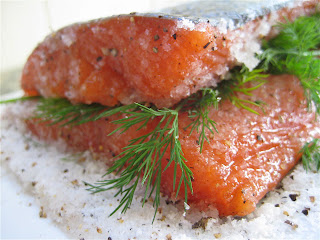
When the weather turns cold and Christmasy, what do you think about? Chances are you think about roaring fires, snowflake-patterned sweaters, or lacing the chestnut stuffing with arsenic. Me, I think about Scandinavian food. In particular, my mind wanders to gravlax.
Perhaps it's just a reaction against all the frosted sugar cookies and enforced glee, but the desire for something clean and salty that comes from a land prone to waves of alcoholism and depression during the long, dark, and cold winter months is irresistible to me.
Gravlax, gravad lax, gravlaks, graavilohi or graflax. However you spell it, it's salmon cured with salt, sugar, and dill. Traditionally, it is served with a gravlaxsas-- a sauce of dill and mustard, and with dense, dark bread or boiled potatoes, but Christmastime is no time to think of tradition, certainly.
Gravlax is a fisherman's dish, originally of salmon salted and the buried in the sand above the high tide line. If you hadn't made the connection between the Scandinavian grav and our word grave, then you weren't paying attention. It should now come as no surprise that the true meaning of gravlax is "salmon dug into the ground." If you, in turn, could now explain to me the true meaning of Christmas, I'll call us even.
The original dish was somewhat fermented, not unlike the way those clever Vietnamese make that lovely fish sauce I used to put into everything, but times have changed. Today, the only burying done to the salmon is in salt and sugar.
If you are as tired of cookies and fudge as I am, this is a great treat to take to a party or have at your own. It's remarkably easy, taking very little skill, which I appreciate during the Holidays. All that is required is a little forward planning.
Gravlax
There are hundreds of recipes for gravlax. I don't know why, since it's basically the product of very few ingredients. The one I used for the purposes of this blog is a good one, but everyone, especially Norwegians, is bound to argue about the exact ratio of salt to sugar. All I have to say is please, not on Christmas, Dawn, not on Christmas.
Ingredients
1 to 2 pounds salmon fillet, sliced into equal pieces. If you want to get fancy, buy center cuts. I, however, do not care.
1/4 cup kosher salt
1/4 cup granulated sugar
1 teaspoon of cracked black pepper
1 bunch of dill
a splash or two of alcohol-- Akvavit is traditional, but vodka or brandy works well, too.
Preparation
1. Remove pin bones, if any, from salmon with needle nose pliers or tweezers.
2. In a small bowl, combine salt, sugar, and pepper.
3. Rub both sides of salmon fillets with salt and sugar mixture. My salt and sugar, when preparing my mise en place for this blog looked very much like a granulated Maidenform bra when poured.

4. Spread remaining sugar and salt mixture onto the pink, fleshy side of the fillets and sprinkle with your booze of choice, but not too much.
5. Lay dill more or less evenly over one of the fillets. I like to crush it in my hands to release the essential oils. Place the second fillet on top of it to form a sandwich, with the salmon acting as the bread. If this is difficult for you to follow, I don't want to know you.

6. Place your "sandwich in an appropriately-sized freezer bag, removing as much air as possible. Close the bag.
7. Place your package in a shallow baking dish or pan and place a weight evenly over it. There is much disagreement about this step. Some people like 5-to-8 pounds of weight, others, none at all. Weighing down the salmon produces a denser finished (or Finnish, in this case) product. I decided to go for something lightweight in both the literal and literary sense.

8. Refrigerate for 2 to 3 days, turning the salmon every 12 hours or so.
9. After the appropriate amount of time, take salmon out of the bag, scrap off most of the dill and pat dry with paper towels. Once cured, the gravlax should stay "fresh", or at least, good, for a week, if refrigerated and well-wrapped.
To serve, slice at a 45 degree angle, as thinly as possible and leaving the skin behind. Drink a little glasas of Akvavit or vodka to toast your good fortunes. Or drink a bit of champagne, that pairs well, too. Did I mention that this is a great New Year's Eve or New Year's Day breakfast dish? No? Well, it is.

1 comment:
Do you have a good recipe for gravlaxsås?
Post a Comment